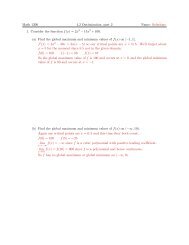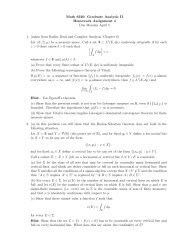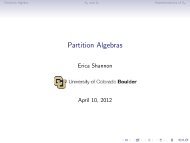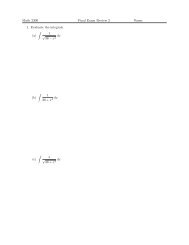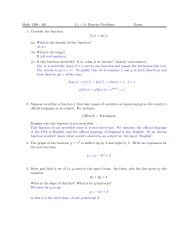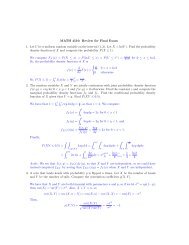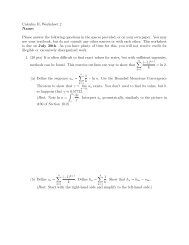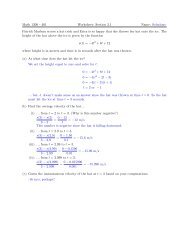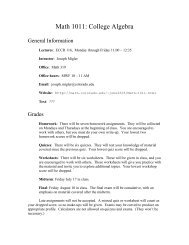You also want an ePaper? Increase the reach of your titles
YUMPU automatically turns print PDFs into web optimized ePapers that Google loves.
<strong>MATH</strong> <strong>2400</strong><strong>Final</strong> <strong>Exam</strong> <strong>Review</strong> <strong>Solutions</strong>1. FindanequationforthecollectionofpointsthatareequidistanttoA(−1, 5, 3)andB(6, 2, −2).∣∣ −→AP∣∣ 2 = ∣∣ −→ ∣∣ ∣∣ ∣∣2BP(x+1) 2 +(y −5) 2 +(z −3) 2 = (x−6) 2 (y −2) 2 +(z +2) 2x 2 +2x+1+y 2 −10y +25+z 2 −6z +9 = x 2 −12x+36+y 2 −4y +4+z 2 +4z +414x−6y −10z = 9.Alternatively, this is the plane with normal vector −→ AB through the midpoint of A and B.2. Using a computer, graph a contour plot of f(x,y) = x 2 y−x 3 and some flow lines of the vectorfield ⃗ F = 〈 1, 3−2 y x〉. What appears to be true? Prove your conjecture.Note that it appears that every flow line lies on a level curve. That is, for any flow line C,given by ⃗r(t), we have that f(⃗r(t)) ≡ k for some constant k. Note that on Cddt (f(⃗r(t))) = ⃗ ∇f ·⃗r ′= ⃗ ∇f · ⃗F= 〈 2xy −3x 2 ,x 2〉·= 0.〈1,3−2 y 〉xThus, f is constant on any flow line. Therefore, every flow line lies on a level curve. However,note that x = 0 is a level cure of f, but the vector field is not defined on the entire line. So,not every level curve is a flow line.
Alternatively, we can solve the differential equationdYdydx = dtdydx + 2 x y = 3dxdtx 2dy +2xy = 3x2dxd (x 2 y ) = 3x 2dxx 2 y = x 3 +kf(x,y) = x 2 y −x 3 = k.= 3−2y x13. Find an equation of the plane through the points (2,4,− 1 2 ), (−1,2,−5 2 ), and (0,1,−3 2 ).Ifwecomputethevectorbetweensuccessivepoints, weget⃗v 1 = 〈−3,−2,−2〉, ⃗v 2 = 〈1,−1,1〉.Thenî ĵ ĵ⃗v 1 ×⃗v 2 =−3 −2 −2∣ 1 −1 1 ∣ = 〈−4,1,5〉(So, one form of the plane would be −4x+(y −1)+5 z + 3 )= 0.24. For each of the following limits, calculate the limit if it exits, otherwise show the limit doesnot exist.(a)(b)x 2 sin 2 ylim(x,y)→(0,0) x 2 +2y 2x 2 sin 2 y0 ≤ lim(x,y)→(0,0) x 2 +2y = lim sin 2 y· lim2 (x,y)→(0,0) y 2 (x,y)→(0,0)= limr→0r 2cos2 θsin 2 θ1+sin 2 θ ≤ limr→0 r2 1·sin2 θ1+sin 2 θ ≤ limr→0 r2 ·1 = 0.x 2 sin 2 yThus, lim(x,y)→(0,0) x 2 +2y = 0. 2lim(x,y)→(0,0)xy 3x 2 +y 6x 2 y 2x 2 +2y 2 = 1·limr→0r 4 cos 2 θsin 2 θr 2 cos 2 θ+2r 2 sin 2 θy = 0 :x = y 3 :lim(x,y)→(0,0)lim(x,y)→(0,0)xy 3x 2 +y 6 = lim(x,0)→(0,0)xy 3x 2 +y 6 =lim(y 3 ,y)→(0,0)x·0 3x 2 +0 6 = limx→0y 3 ·y 3(y 3 ) 2 +y 6 = limy→00x 2 = limx→0 0 = 0y 62y = lim 16 y→0 2 = 1 2 ≠ 0.(c)xy 3Thus, lim does not exist.(x,y)→(0,0) x 2 +y6 xyzlim(x,y,z)→(0,0,0) x 2 +y 2 +z 2∣ ∣ ∣ 0 ≤xyz ∣∣∣ ∣∣∣ ρ 3 cosθsinθsin 2 φcosφ ∣∣∣∣ lim = lim≤ limρ = 0(x,y,z)→(0,0,0) x 2 +y 2 +z 2 ρ→0 ρ 2 ρ→0Thus,lim(x,y,z)→(0,0,0)xyzx 2 +y 2 +z 2 = 0.
5. Two tugs are pulling a boat, one pulling in the direction 60 ◦ North of East and is half asstrong as the other tug. In what direction should the stronger tug pull in order for the boatto move due East? If the weaker tug is moving at a speed of 10 mph, at what speed is theboat traveling?If unattached, the weaker tug would be moving at a speed of 10sin(60 ◦ ) = 5 √ 3 mph North.If the stronger tug is pulling at an angle θ South of East, its unattached vertical speed wouldbe 20sinθ mph. Since we need the boat to travel due East, we have 20sinθ = 5 √ 3, and so,(√ )3θ = sin −1 ≈ 25.66 ◦ . Then, the horizontal speed of the boat, which is the combined4( (√ )) ( 3 1horizontal speed of the tugs, would be 10cos(60 ◦ ) + 20cos sin −1 = 10 +4 2)(√ )1320 = 5( √ 13+1) ≈ 23.0277 mph.46. Find the acute angle between two diagonals of a cube.The four vectors along the diagonals are 〈1,1,1〉,〈−1,1,1〉,〈−1,−1,1〉,〈1,−1,1〉. Note thatthe dot product between any two of these vectors would be ±1, and the length of each vectoris √ ( )3. So, the acute angle measurement is cos −1 1√ 2 = cos −1( 13 3).7. Let f(x,y) = xesin(x2 y)(x 2 +y 2 ) 3/2. Compute f x(1,0). Hint: There is an easy way.Let g(x) = f(x,0) =xe 0(x 2 +0 2 ) 3 2= 1 x 2. So, f x(1,0) = g ′ (1) = −2x 3 ∣∣∣∣x=1= −2.8. Find the tangent plane to the following surfaces at the given point:(a) z = e 2y−x siny at (3π, 3π 2 ,−1).⃗∇z = 〈 −e 2y−x siny,2e(2y −xsiny +e 2y−x cosy 〉(⃗∇z 3π, 3π )= e 0 〈−(−1),2+0〉 = 〈1,−2〉2So, the tangent plane is z = 1·(x−3π)−2 ( )y − 3π 2 −1 = x−2y −1.(b) ⃗r(u,v) = 〈u 2 ,u−v 2 ,v 2 〉 at (x,y,z) = (1,−2,1).A plane is defined by a normal vector and a point. Recall ⃗r u and ⃗r v are tangent tothe surface, and so, ⃗r u ×⃗r v is perpendicular to the surface. Note ⃗r u = 〈2u,1,0〉, ⃗r v =〈0,−2v,2v〉 = 2v〈0,−1,1〉,andso,⃗r u ×⃗r v = 2v〈1,−2u,−2u〉.Now, howdoes(x,y,z) =(1,−2,1) correspond to (u,v)? x = z = 1 gives us u 2 = v 2 = 1, and so u = ±1,v = ±1.Also, −2 = y = u−v 2 = u−1, which gives us u = −1. So, a normal vector is 〈1,2,2〉,giving us a tangent plane (x−1)+2(y +2)+2(z −1) = 0, or x+2y +2z = −1.9. Two legs of a right triangle are measured at 8cm and 15cm, each with a maximum error of0.2cm. Estimate the maximum error in computing the area and the hypotenuse.
A = 1 2 xydA = 1 2 ydx+ 1 A·( dx2 xdy = x + dy )y( |∆A| ≈∆x∣ A x + ∆y )∣ ( ∣∣∣ |∆x|≤ Ay x + |∆y| )yH = √ x 2 +y 2dH =x√x2 +y dx+ y√ 2 x2 +y dy = 1 2 H (xdx+ydy)∣ |∆H| ≈1 ∣∣∣∣H (x∆x+y∆y) ≤ 1 H (x|∆x|+y|∆y|) = 117≤ 1 ( .22 (8)(15) 8 + .2 )= 2.3 cm 215(8(.2)+15(.2)) =46170≈ .2706 cm.10. Parameterize the line that is tangent to z = x 2 + y 2 and 4x 2 + y 2 + z 2 = 9 at the point(−1,1,2).Recall that the 3D-gradient of a surface gives a vector perpendicular to the surface. If wecross the two gradients, we will get a vector that is perpendicular to both gradients, and so,tangent to both surfaces. The line starting at our point, pointing along the vector, will be theline we want.11. Calculate ∂z∂x⃗∇(x 2 +y 2 −z) = 〈2x,2y,−1〉 ↦→ 〈−2,2,−1〉⃗∇(4x 2 +y 2 +z 2 −9) = 〈8x,2y,2z〉 ↦→ 〈−8,2,4〉 = 2〈4,−1,−2〉〈2x,2y,−1〉×〈4,−1,−2〉 = 〈−5,−8,−6〉and∂z∂y for(a) the surface defined by x 2 +zsin(xyz) = 0.⃗r(t) = 〈−1,1,2〉+t〈5,8,6〉.0 = d(0) = d ( x 2 +zsin(xyz) ) = 2xdx+sin(xyz)dz +cos(xyz)(yzdx+xzdy +xydz)(−sin(xyz)−xycos(xyz)) dz = (2x+yzcos(xyz)) dx+xzcos(xyz)dydz = ∂z∂x(b) z =∫ xy 20∂z 2x+yzcos(xyz)dx+ dy = −∂y sin(xyz)+xycos(xyz) dx−e t2 dt.∂z∂x = e(xy2 ) 2 ·y 2xzcos(xyz)sin(xyz)+xycos(xyz) dy∂z∂y = e(xy2 ) 2 ·2xy12. A function f(x,y) is called homogeneous of degree n if for every t > 0, f(tx,ty) = t n f(x,y).Show that if f(x,y) is homogeneous of degree n, then x ∂f∂x +y∂f ∂y = nf.t n f(x,y) = f(tx,ty)ddt (tn f(x,y)) = d dt (f(tx,ty))nt n−1 f(x,y) = f x (tx,ty)·x+f y (tx,ty)·yt = 1 : nf(x,y) = f x (x,y)·x+f y (x,y)·y.
13. Let z = f(x 2 +lny). Calculate ∂2 z∂x 2, ∂2 z∂y 2, and ∂2 z∂x∂y .z x = 2xf ′( x 2 +lny ) z xx = 2f ′( x 2 +lny ) +4x 2 f ′′( x 2 +lny )z y = 1 y f′( x 2 +lny )z yy = −1y 2 f′( x 2 +lny ) + 1 y 2f′′( x 2 +lny )z yx = z xy = 2x y f′′( x 2 +lny )14. Compute the Taylor series centered at (0,0) of f(x,y) =convergence, and on what set does the series converge?∞11−x 2 −y = 12 1−(x 2 +y 2 ) = ∑( x 2 +y 2) nn=011−x 2 −y2. What is the radius ofThe series will converge where ∣ ∣x 2 +y 2∣ ∣ = x 2 + y 2 < 1. This is the open disk of radius 1,centered at the origin. Note: You should now be more comfortable with the terminology”radius of convergence.”{ √ xyif (x,y) ≠ (0,0)15. Let f(x,y) =x 2 +y 2 . Is f continuous? Differentiable?0 if (x,y) = (0,0)Note that away from the origin, f is a quotient of functions that are differentiable, hence, fis differentiable except possibly at (0,0).∣ ∣ ∣∣∣ ∣∣∣ ∣ lim f(x,y) r 2 cosθsinθ= lim(x,y)→(0,0) r→0 r ∣ = lim r|cosθsinθ| ≤ lim r = 0 = f(0,0).r→0 r→0So, f is continuous at (0,0).f x (0,0) = limh→0f(h,0)−f(0,0)h√ h·0h−02 +0 2h→0= limh0= limh→0 h = lim0= 0.h→0Similarly, f y (0,0) = 0. So, the best linear approximation to f at (0,0) is L(x,y) = 0(x−0)+0(y −0)+0 = 0. So, E(x,y) = f(x,y)−L(x,y) = f(x,y).lim(x,y)→(0,0)E(x,y)√x2 +y 2 = lim(x,y)→(0,0)Thus, f is not differentiable at (0,0).xyx 2 +y = lim r 2 cosθsinθ2 r→0 r 216. Find and classify all critical points of f(x,y) = 4 3 x3 −xy 2 +y.f x = 4x 2 −y 2 = 0f y = −2xy +1 ⇒f xx = 8x f xy = −2y f yy = −2x= limr→0cosθsinθ = cosθsinθ =θ=π4(± 1 2 ,±1 )D(x,y) = (8x)(−2x)−(−2y) 2 = −16x 2 −4y 2 < 0 for (x,y) ≠ (0,0)So, ( ± 1 2 ,±1) are saddle points.12 ≠ 0.
17. Find the absolute max/min of f(x,y) = x 2 +2y 2 −x over the disk x 2 +y 2 ≤ 4.Note that f is a continuous function, restricted to a compact set. So, we are guaranteed thatf will attain a global max and min on the closed disk. Furthermore, they must occur at eithercritical points on the interior, or on the boundary.Interior:f x = 2x−1 = 0( ) 1f y = 4y = 0 ⇒2 ,0We shall apply the method of Lagrange multipliers to the boundary.〈2x−1,4y〉 = λ〈2x,2y〉2x−1= λ = 4y2x 2yy = 0 ⇒ x = ±2y ≠ 0 ⇒ 2x−1 = 22x2x−1 = 4xx = − 1 2 ⇒ y = ± √4−(−2) 1 2√15= ±2( ) (1f2 ,0 = − 1 4 < f(2,0) = 2 < f(−2,0) = 6 < f − 1 √ )152 ,± 2= 33418. (Challenging!) Consider the ellipsoid x29 + y24 + z2= 1 with a point P on the surface in25the first octant (specifically, where each coordinate is greater than zero). Then the coordinateplanes and the tangent plane at P define a tetrahedron in the first octant. Find the point Pthat will minimize the volume of the resulting tetrahedron.First, an outline of the solution. We will find the tangent plane at an arbitrary point, and findthe volume of the resulting tetrahedron. This then defines a volume function, dependent onthe base point. From there, we will apply the method of Lagrange multipliers to the volumefunction in order to find the minimum.(Consider the point P(a,b,c) with a,b,c > 0. Since ∇ ⃗ x2have that the tangent plane to the surface at P is9 + y24 + z225)=〈 29 x, 2 4 y, 225 z 〉, we0 = 2 9 a(x−a)+ 2 4 b(y −b) 2 c(z −c)[ 25a= 29 x+ b 4 y + c ( )] a225 z − 9 + b24 + c2251 = x 9a+ y 4b+ z 25cRecall: For a,b,c > 0, the volume in the first octant under the plane x a + y b + z c9aSo, the volume of our tetrahedron is · 4 · 25b c= 150 . Thus, for any point P(x,y,z) satisfying6 abcx 29 + y24 + z225= 1 isabc6 .= 1 and x,y,z > 0, the volume of the resulting tetrahedron is V(x,y,z) =150xyz .
Notice that we are not working over a closed set, however, as x,y or z approach 0, that volumeapproaches infinity. So, if we restrict the value to say x2 + y2+ z2 = 1 and x,y,z ≥ .0019 4 25we are only removing points with a corresponding larger volume, and so, will not changethe minimum (should it exist). However, V is continuous on our new set, which is compact.So, we are guaranteed a minimum on that set. To find the minimum, we shall proceed byLagrange multipliers.( )⃗∇V(x,y,z) = λ∇⃗ x29 + y24 + z225〈 1−Vx , 1 y z〉, 1 〈 x= 2λ9 , y 4 25〉, z− V 2λ = x29 = y24 = z225Substituting into our constraint, we get19. Evaluate the following integrals:3· x29 = 1 ⇒ x = 3 √3⇒ P(x,y,z) =( 3 √3 ,2√3,)5√ . 3(a)∫ 16 ∫ 40√ ye x3 dxdy(b)∫∫∫ 16 ∫ 40√ ye x3 dxdy =∫ 4 ∫ x 200e x3 dydx =∫ 40[ ] 4 1x 2 e x3 dx =3 ex3 0= e64 −1.3ydA where R is the region in the first quadrant bounded by xy = 16, y = x and(c)Rx = 8. ∫ 8∫∫∫4∫ x16xydydx =∫ 8412 x2 − 27 176dx =x2 3 .zdV, where G is the solid in the first octant bounded by x+y = 2 and y 2 +z 2 = 4.G(d)∫∫R∫ π20∫ 2 ∫ 2−rsinθ00rcosθ ·rdxdrdθ ==∫ π20163∫ π20∫ 2cosθ −4sinθcosθdθ =103 .0r 2 cosθ(2−rsinθ) drdθsin(x−y)cos(x+y) dA where R is the region bounded by y = 0, y = x, and x+y = π 4 .x = u+v2y = v −u2
⎧⎨⎫⎬⎧y = 0 ⎨y = x⎩x+y = π ⎭ ↦→ ⎩4u = vu = 0v = π 4⎫⎬⎭∣∂(x,y) ∣∣∣ 1∂(u,v) = 2− 1 21212∣ = 1 2∫∫R∫ πsin(x−y)cos(x+y) dA = 40∫ v0∫ πsinucosv dudv = 40−1+ 1cosv dv = ln(√ 2+1)− π 4 .(e)(f)∫ √21 ∫ √ 4−x 20∫ √ 320√1−x 2∫ √ 2−x 21√3x√x2 +y 2 dydx+∫ √ 2∫ √ 4−x 2 −y 2=∫ √ 4−x 2√1x 2∫ π ∫2 2√x 2 +y 2 (x 2 +y 2 +z 2 ) 3 dzdydx.π41√x2 +y 2 dydx.√r2 rdrdθ = 143 π.=∫ π2π6∫ π40∫ 20(ρ2 ) 3ρ 2 sinφdρdφdθ =( π2 − π [ ] 2[−cosφ]6)π 4 109 ρ9 = 512π (2− √ )2 .02720. (Hard) Three identical cylinders with radii R intersect at the same point at right angles.Find the volume of their intersection.Consider the cylinders x 2 + y 2 = R 2 , x 2 + z 2 = R 2 , y 2 + z 2 = R 2 . Using symmetry, we canrestrict out attention to z ≥ 0, x ≥ y ≥ 0, giving us16∫∫√R2 −x 2 dA = 160≤y≤x≤Rx 2 +y 2 ≤R 2∫ π40∫ π4= 16= 160∫ π40∫ R0= 16 3 R3 ∫ π4= 16 3 R3 ∫ π4r √ R 2 −r 2 cos 2 θdrdθ[− 1 ]( RR 2 −r 2 cos 2 θ )3 23cos 2 θ0− 13cos 2 θ R3 sin 3 θ+ R33cos 2 θ dθ( )sec 2 − 1−cos2 θsinθ dθ0 cos 2 θ(sec 2 θ− sinθ )cos 2 θ +sinθ dθ0= 16 [3 R3 tanθ − 1]πcosθ −cosθ 4= 16 3 R3 (1− √ 2−0)2 −0+1+1√2= 16 (3 R3 3− 3 )√ (2 = 8R 3 2− √ 22).dθ21. Find the surface area of the portion of the cylinder x 2 +y 2 = 9 above the xy-plane, and belowx+y +3z = 20.
⃗r(θ,z) = 〈3cosθ,3sinθ,z〉⃗r θ = 〈−3sinθ,3cosθ,0〉 ⃗r z = 〈0,0,1〉√||⃗r θ ×⃗r z || = ||〈3cosθ,3sinθ,0〉|| = 9cos 2 θ+9sin 2 θ+0 = 3∫∫ ∫ 2π ∫ 12 (20−3cosθ−3sinθ)dS =3dzdθS=0∫ 2π0= 40π.020−3cosθ−3sinθdθ22.23.24.For the following problems, all closed curves are oriented counterclockwise when viewed fromabove, and surfaces are oriented outward/upward unless other wise stated.∫x 2 dx+xydy +z 2 dz, C :⃗r(t) = 〈 sint,cost,t 2〉 , 0 ≤ t ≤ π.∫∫CCCx 2 dx+xydy+z 2 dz =∫ π0sin 2 t·cost+sintcost(−sint)+(t 2 ) 2 (2t)dt =∫ π02t 5 dt = π63 .2xcos(x 2 z)dx+zdy+ ( x 2 cos(x 2 z)+y ) dz, where C is the intersection of z = 3x 2 +y 3 +5and y = x 3 −3 from x = 0 to x = 1.∮C∫C2xcos(x 2 z)dx+zdy + ( x 2 cos(x 2 z)+y ) dz=∫ (1,−2,0)(0,−3,−22)⃗∇ ( yz +sin(x 2 z) )·d⃗r= (−2)(0)+sin(0)−(−3)(−22)−sin(0) = −66.(x + y 2 )dx + (1 + x 2 )dy where C is the boundary of the region enclosed by y = x 2 andy = x 3 .25.∮C∫C(x+y 2 )dx+(1+x 2 )dy =Green’s∫ 1=0∫ 1 ∫ x 20x 3 (2x−2y) dydx2x 3 −x 4 −2x 4 +x 6 dx = 370 .〈x 2 y, 1 〉3 x3 ,xy ·d⃗r where C is the intersection of z = y 2 −x 2 and x 2 +y 2 = 1.Let S be the surface z = y 2 −x 2 over x 2 +y 2 ≤ 1, which will have boundary curve C.
∮C〈x 2 y, 1 〉 ∫∫3 x3 ,xy ·d⃗r =Stokes’=∫∫S〈curl x 2 y, 1 〉3 x3 ,xy ·dS⃗〈x,−y,0〉·〈2x,−2y,1〉 dA26.x 2 +y 2 ≤1∫ 2π ∫ 1= 2r 2 ·rdrdθ = π.0 0∮〈xy,yz,zx〉·d⃗r where C is the triangle (1,0,0), (0,1,0), (0,0,1).CLet S be the flat interior of C, given by x+y +z = 1, 0 ≤ y ≤ 1−x ≤ 1.∮C∫∫〈xy,yz,zx〉·d⃗r =Stokes’∫∫=Scurl〈xy,yz,zx〉·d ⃗ S〈−y,−z,−x〉·〈1,1,1〉 dAR∫∫=−(x+y +z) dAR∫∫= −1·dA = − 1 2R27.∮〈x,y,x 2 +y 2〉·d⃗r where C is the boundary of the portion of the paraboloid z = 1−x 2 −y 2Cin the first octant.Let S be the portion of z = 1−x 2 −y 2 inside C.∮C〈x,y,x 2 +y 2〉·d⃗r ∫∫=Stokes’∫∫=Scurl 〈 x,y,x 2 +y 2〉·d ⃗ S〈2y,−2x,0〉·〈2x,2y,1〉 dAR∫∫=0dA = 0R28.∫∫Scurl 〈 xsin 2 z,3x,z +tan −1 (xy) 〉 · d ⃗ S where S is the portion of z = √ 9−x 2 −y 2 insidex 2 +y 2 = 4.By either applying Stokes’ twice or divergence theorem, any surface with same orientationand boundary as S will have the same surface integral. Let S ′ be the disk z = √ 5 withx 2 +y 2 ≤ 4.
∫∫Scurl 〈 xsin 2 z,3x,z +tan −1 (xy) 〉·d S ⃗ =∫∫=Divergence= 3x 2 +y 2 ≤4∫∫∫∫x 2 +y 2 ≤4curl 〈 xsin 2 z,3x,z +tan −1 (xy) 〉·d S ⃗S〈′ 〉x −y1+x 2 y 2, 1+x 2 y 2,3 ·〈0,0,1〉 dAdA = 12π.29.∫∫curl 〈 x 2 e yz ,y 2 e xz ,z 2 e xy〉·d S ⃗ where S is the top half of the sphere x 2 +y 2 +z 2 = a 2 .SNote that S ′ , the disk z = 0 with x 2 +y 2 ≤ a 2 , has the same boundary curve as S.∫∫Scurl 〈 x 2 e yz ,y 2 e xz ,z 2 e xy〉·d S ⃗ =∫∫=30. Find the flux of ⃗ F through the surface S.Divergence∫∫S ′ curl 〈 x 2 e yz ,y 2 e xz ,z 2 e xy〉·d ⃗ Scurl 〈 x 2 e yz ,y 2 e xz ,z 2 e xy〉·〈0,0,1〉 dAx 2 +y 2 ≤a∫∫2= z ( y 2 e xz −x 2 e yz) dAx 2 +y 2 ≤a∫∫2= 0·(y 2 e 0 −x 2 e 0) dAx 2 +y 2 ≤a∫∫2= 0dA = 0.x 2 +y 2 ≤a 2(a) ⃗ F = 〈xze y ,−xze y ,z〉, S is the portion of x + y + z = 1 in the first octant, orienteddownward.∫∫S⃗F·d ⃗ S =∫ 1 ∫ 1−x〈xze y ,−xze y ,z〉·〈−1,−1,−1〉 dydx =∫ 1 ∫ 1−x0 00 0−xze y +xze y −zdydx=∫ 1 ∫ 1−x00−1+x+ydydx =∫ 10−(1−x) 2 + 1 2 (1−x)2 dx = − 1 6 .(b) ⃗ F = 〈x,y,z〉, S is the upper half of the sphere x 2 +y 2 +z 2 = a 2 .∫∫S∫∫⃗F ·dS ⃗ =S⃗r ·∫∫⃗r||⃗r||∫∫SdS = ||⃗r|| dS = adS = a· 1S 2 ·4πa2 = 2πa 3 .(c) ⃗ F = 〈 3x,xz,z 2〉 , S is the boundary of the solid bounded by z = 4−x 2 −y 2 and z = 0.
∫∫S⃗F ·d ⃗ S =Divergence=∫∫0x 2 +y 2 ≤4∫ 2π ∫ 2 ∫ 4−r 2= 2π0 0∫ 20= 1363 π.0∫ 4−x 2 −y 2div ⃗ F dzdA(3+2z)rdzdrdθr ( 3(4−r 2 )+(4−r 2 ) 2) dr(d) ⃗ F = 〈 x 2 +sin(yz),y −xe −z ,z 2〉 , S is the boundary of the solid bounded by x 2 +y 2 =4, x+z = 2 and z = 0.∫∫S⃗F ·d ⃗ S =Divergence=∫∫∫∫x 2 +y 2 ≤4∫ 2−x02x+1+2zdzdA(2x+1)(2−x)+(2−x) 2 dA===x 2 +y 2 ≤4∫∫x 2 +y 2 ≤4∫ 2π ∫ 20∫ 2π0= 20π.0−x 2 −x+6dA−r 3 cos 2 θ −r 2 cosθ +6rdrdθ−4cos 2 θ− 8 3 cosθ+12dθ(e) ⃗ F = 〈2,5,3〉, S is the portion of the cone z = √ x 2 +y 2 inside x 2 +y 2 = 1. What if Swere instead the portion of z = x 2 +y 2 inside x 2 +y 2 = 1?Notice that the cone and the paraboloid can both be continuously deformed to the disk,,S ′ : z = 1, x 2 +y 2 ≤ 1 and div ⃗ F = 0, so the flux through all three surfaces will be equal.∫∫S ′ ⃗ F ·d ⃗ S =∫∫x 2 +y 2 ≤1〈2,5,3〉·〈0,0,1〉 dA = 3∫∫x 2 +y 2 ≤1dA = 3π.31. For each of the following, determine if the statement is true or false. If true, make sure youcan prove it or explain why. if false, give a counterexample.(a) For ∫ every pair of differentiable functions of one variable, f and g, the line integralf(x)dx+g(y)dy is path independent.CSincef andg aredifferentiable, ∫ theyhaveantiderivatives, F,G.Since∇(F(x)+G(y)) ⃗ =〈f(x),g(y)〉, then f(x)dx+g(y)dy is path independent.C(b) ⃗ F = 〈 xy 2 ,x 2 x 〉 is an example of a vector field.⃗F = 〈 xy 2 ,x 2 z 〉 has three inputs, but only two outputs, and so, ⃗ F cannot be a vectorfield.
∫(c)Cxx 2 +y 2 dx−ydy is path independent.x 2 +y2 〈 〉 〈 x −yx 2 +y 2, x 2 +y 2,0 = 0,0,〉x 2 +y 2〉−2xycurl(x 2 +y 2 ) 2 − 2xy(x 2 +y 2 ) 2 ≠⃗0.〈 ∫x −ySo,x 2 +y 2, is not conservative. Thus,Cindependent.∮(d) If ⃗F ·d⃗r = 0 for a simple closed curve C, then F ⃗ is conservative.Cxx 2 +y dx− y dy is not path2 x 2 +y2 Consider ⃗ F = 〈0,0,1−x 2 −y 2 〉. Then curl ⃗ F = 〈−2y,2x,0〉 ≠ ⃗0, so ⃗ F is not conservative.However, for C : ⃗r(t) = 〈cosθ,sinθ,0〉, 0 ≤ t ≤ 2π, a simple closed curve,∮C⃗F ·d⃗r =∫ 2π0⃗F (⃗r(t))·⃗r ′ (t)dt =∫ 2π(e) If ∇ 2 f = ∇·∇f ≡ 0 then ∫ C f ydx−f x dy is path independent.Let C be a simple closed curve.∫C0⃗0·⃗r ′ (t)dt = 0.∫∫∂f y dx−f x dy =Green’sR ∂x (−f x)− ∂ ∂y (f y) dA∫∫= − f xx +f yy dA∫∫R= − ∇ 2 f dA∫∫R= − 0dA= 0.(f) There is a vector field ⃗ F such that curl ⃗ F = 〈2x,3yz,−xz 2 〉.RRecallthatforanyvectorfield ⃗ F,divcurl ⃗ F = 0.Sincediv〈2x,3yz,−xz 2 〉 = 2+3z+x ≠ 0,then 〈2x,3yz,−xz 2 〉 is not the curl of any vector field.



